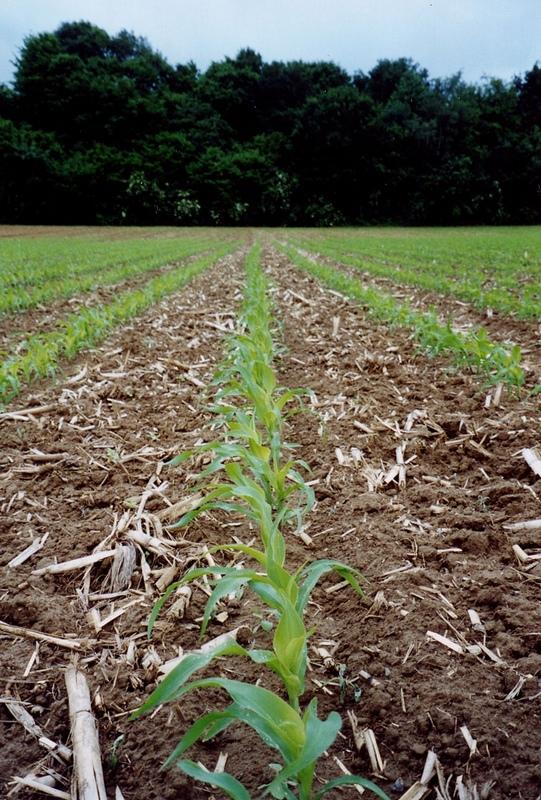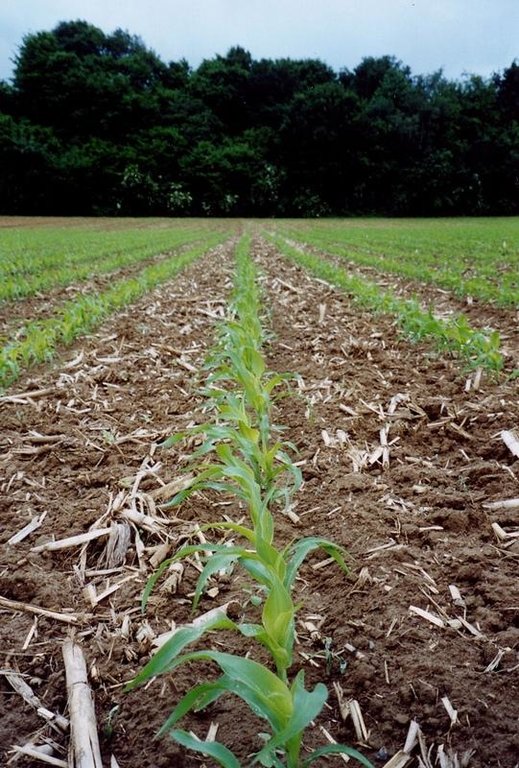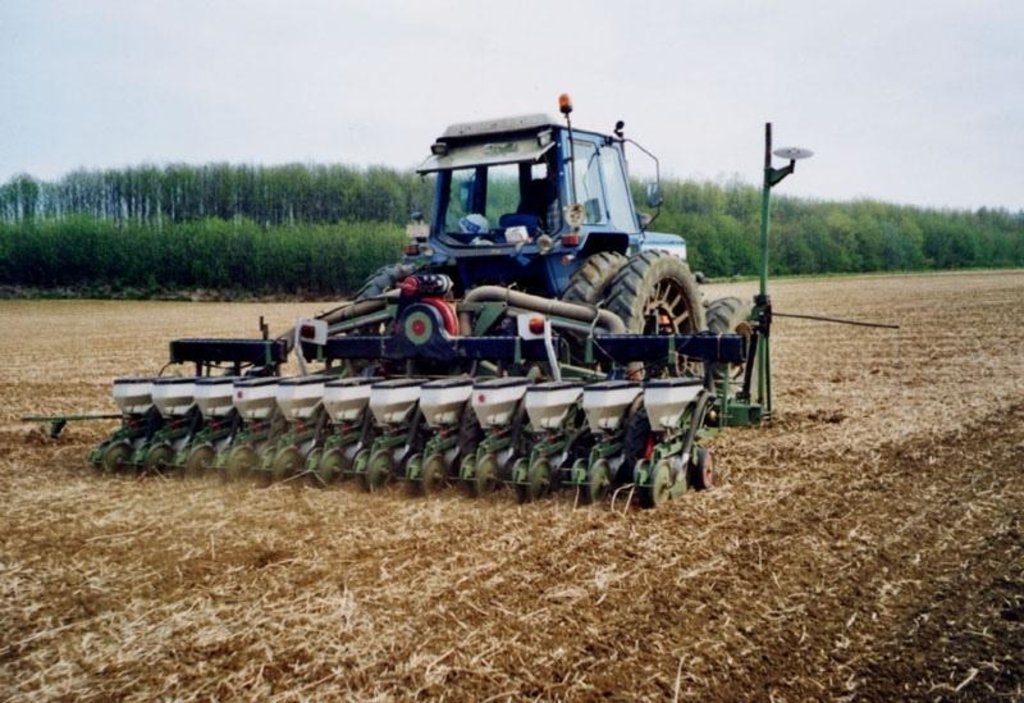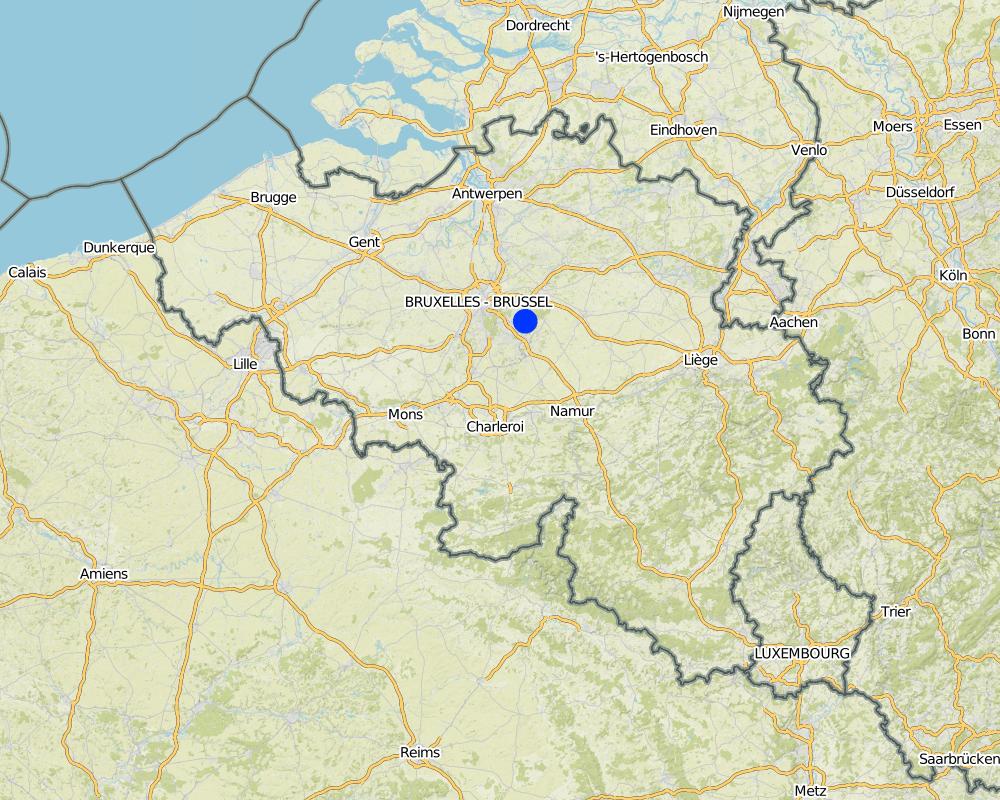Non-inversion shallow cultivation [Belgique]
- Création :
- Mise à jour :
- Compilateur : Unknown User
- Rédacteur : –
- Examinateur : David Streiff
Oppervlakkige niet-kerende bodembewerking
technologies_966 - Belgique
Voir les sections
Développer tout Réduire tout1. Informations générales
1.2 Coordonnées des personnes-ressources et des institutions impliquées dans l'évaluation et la documentation de la Technologie
Personne(s)-ressource(s) clé(s)
Spécialiste GDT:
Gillijns Katleen
Catholic University of Leuven
Belgique
Spécialiste GDT:
Govers Gerard
Catholic University of Leuven
Belgique
Nom du projet qui a facilité la documentation/ l'évaluation de la Technologie (si pertinent)
Soil and water protection (EU-SOWAP)Nom du ou des institutions qui ont facilité la documentation/ l'évaluation de la Technologie (si pertinent)
Catholic University of Leuven (KU Leuven) - Belgique1.3 Conditions relatives à l'utilisation par WOCAT des données documentées
Quand les données ont-elles été compilées (sur le terrain)?
08/11/2010
Le compilateur et la(les) personne(s) ressource(s) acceptent les conditions relatives à l'utilisation par WOCAT des données documentées:
Oui
1.5 Référence au(x) questionnaire(s) sur les Approches de GDT
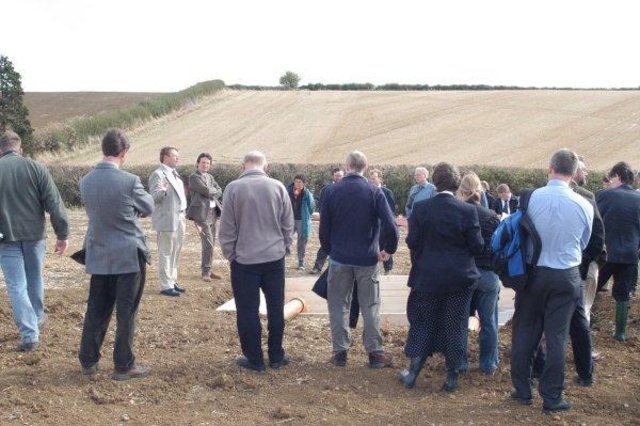
Introduction of conservation agriculture in a highly mechanised … [Belgique]
Combination of 'dissemination of the SWC technology 'non-inversion tillage'' and research.
- Compilateur : Unknown User
2. Description de la Technologie de GDT
2.1 Courte description de la Technologie
Définition de la Technologie:
The technology consists of the use of cover crops and of a non-inversion seedbed preparation
2.2 Description détaillée de la Technologie
Description:
The technology consists of agronomic measures. The most important thing is that the farmers are not allowed to invert the soil by ploughing. Farmers may only cultivate their fields as minimum and as shallow as possible. Farmers also have to use a cover crop, if possible. In this way the soil is always covered with residues of a previous crop or with residues of the cover crop. The improvement of the ground cover protects the soil against different kinds of water erosion. In the long term period, the soil structure will improve (more organic matter in top soil) and more earthworm activity will be determined. The infiltration of water will increase.
Purpose of the Technology: Protecting the soil against erosion and increasing infiltration.
Establishment / maintenance activities and inputs: The farmer may never plough.
Natural / human environment: The technology is applied on cropland with annual crops.
2.3 Photos de la Technologie
2.5 Pays/ région/ lieux où la Technologie a été appliquée et qui sont couverts par cette évaluation
Pays:
Belgique
Région/ Etat/ Province:
Flanders
Autres spécifications du lieu:
Vlaams-Brabant
Map
×2.6 Date de mise en œuvre de la Technologie
Si l'année précise est inconnue, indiquez la date approximative: :
- il y a moins de 10 ans (récemment)
2.7 Introduction de la Technologie
Spécifiez comment la Technologie a été introduite: :
- au cours d'expérimentations / de recherches
Commentaires (type de projet, etc.) :
In the Walloon part of Belgium and in the surrounding countries (France, Germany), farmers are already applying this technology for a long time. In Flanders, the technology was introduced in the '1970 by a professor De Ploey of our Faculty. Farmers didn't see the benefits of the technology and decided not to implement the technology. Now time has changed: farmers know that they have to do something ageist the erosion problem.
3. Classification de la Technologie de GDT
3.1 Principal(aux) objectif(s) de la Technologie
- réduire, prévenir, restaurer les terres dégradées
3.2 Type(s) actuel(s) d'utilisation des terres, là où la Technologie est appliquée

Terres cultivées
- Cultures annuelles
Principales cultures (vivrières et commerciales):
Major cash crop: Sugar beet
Commentaires:
Major land use problems (compiler’s opinion): 1. Soil loss by water erosion. 2. soil erosion related environmental problems (muddy floods, retention pond sedimentation, declining water quality due to sediment and sediment - fixed contaminants)
Major land use problems (land users’ perception): Strong nitrogen regulations and EU rules are hindering the farmer.
Type of cropping system and major crops comments: Normal sequence of crops at the farm: sugar beet - wheat- potatoes - maize. Crop rotation at the experimental field: maize - wheat - sugar beet.
3.3 Informations complémentaires sur l'utilisation des terres
Approvisionnement en eau des terres sur lesquelles est appliquée la Technologie:
- pluvial
Nombre de période de croissance par an: :
- 1
Précisez:
Longest growing period from month to month: Mar-Oct; Second longest growing period from month to month: Apr - Nov
3.4 Groupe de GDT auquel appartient la Technologie
- Amélioration de la couverture végétale/ du sol
- perturbation minimale du sol
3.5 Diffusion de la Technologie
Spécifiez la diffusion de la Technologie:
- répartie uniformément sur une zone
Commentaires:
Total area covered by the SLM Technology is 0.0046 km2.
It's a fiedl trial with 3 treatments: every treatment is 4620 m² (see map). The treatments are: non-inversion shallow cultivation, non-inversion deep cultivation and conventional ploughing. In the region of this field, other farmers are also experimenting with new technologies on their own fields.
3.6 Mesures de GDT constituant la Technologie

pratiques agronomiques
- A2: Matière organique/ fertilité du sol
- A3: Traitement de la couche superficielle du sol
- A4: Traitement de la couche profonde du sol
Commentaires:
Type of agronomic measures: better crop cover, manure / compost / residues, mineral (inorganic) fertilizers, breaking compacted topsoil, minimum tillage
3.7 Principaux types de dégradation des terres traités par la Technologie

érosion hydrique des sols
- Wt: perte de la couche superficielle des sols (couche arable)/ érosion de surface
- Wg: ravinement/ érosion en ravines
- Wo: effets hors-site de la dégradation

dégradation physique des sols
- Pk: scellage et encroûtement
Commentaires:
Main causes of degradation: other natural causes (avalanches, volcanic eruptions, mud flows, highly susceptible natural resources, extreme topography, etc.) specify (soil erosion), lack of knowledge
Secondary causes of degradation: other human induced causes (specify) (agricultural causes: hevay machinery)
3.8 Prévention, réduction de la dégradation ou réhabilitation des terres dégradées
Spécifiez l'objectif de la Technologie au regard de la dégradation des terres:
- prévenir la dégradation des terres
4. Spécifications techniques, activités, intrants et coûts de mise en œuvre
4.2 Spécification/ explications techniques du dessin technique
Technical knowledge required for field staff / advisors: high
Technical knowledge required for land users: high
Main technical functions: improvement of ground cover, increase of infiltration, improvement of soil structure
Secondary technical functions: control of raindrop splash, control of dispersed runoff: impede / retard, increase in organic matter
Better crop cover
Material/ species: winter barley 2003
Quantity/ density: 200 kg/ha
Agronomic measure: removing less vegetation cover (every year)
Remarks: by not ploughing
Agronomic measure: better crop cover2004
Material/ species: maize 2004
Quantity/ density: 178600
Remarks: seeds/ha
Agronomic measure: better crop cover 2004
Material/ species: winter wheat 2004
Quantity/ density: 165 kg/ha
Agronomic measure: better crop cover 2005
Material/ species: oats 2005
Quantity/ density: 110 kg/ha
Manure / compost / residues
Material/ species: slury injection 2004
Quantity/ density: 40000l/ha
Remarks: before sowing
Mineral (inorganic) fertilizers
Material/ species: nitrogen 2004
Quantity/ density: 200kg/ha
Remarks: 26%
Agronomic measure: mineral (inorganic) fertilizers
Material/ species: nitrogen 2005
Quantity/ density: 175 kg/ha
Remarks: 39%
Agronomic measure: mineral (inorganic) fertilizers
Material/ species: nitrogen 2005
Quantity/ density: 45 kg/ha
Remarks: 27%
Agronomic measure: mineral (inorganic) fertilizers
Material/ species: Haspargit
Quantity/ density: 800 kg/ha
Agronomic measure: mineral (inorganic) fertilizers
Material/ species: nitrogen 2005
Quantity/ density: 120 kg/ha
Remarks: 38%
Minimum tillage
Material/ species: every year
Remarks: the field is cultivated as minimal as possible
4.6 Activités d'entretien/ récurrentes
| Activité | Type de mesures | Calendrier/ fréquence | |
|---|---|---|---|
| 1. | sowing maize, inorganic nitrogen | Agronomique | apr 2004 / |
| 2. | sowing winter barley | Agronomique | oct 2003 / |
| 3. | injection of slurry, herbicide paraquat | Agronomique | mar 2004 / |
| 4. | spraying herbicides | Agronomique | may 2004 / |
| 5. | harvesting, sowing winter wheat | Agronomique | nov 2004 / |
4.7 Coûts et intrants nécessaires aux activités d'entretien/ récurrentes (par an)
Commentaires:
Comparing to ordinary field operations, there are normally no additional costs if applying the new technique. The farmer will not plough anymore, this is an economic benefit. In some cases and for some crops the farmer will use another machine, for example: the farmer will need a direct drilling machine for sowing sugar beets in stead of a normal sowing machine. In Flanders, always agricultural contractors are sowing beets (not farmers). The agricultural contractor will ask the same price for normal sowing machine as for the direct drilling machine. Although farmers have no additional costs, they get subsidies (80€/ha.year for shallow cultivation, 200€/ha.year for no tillage) from the Flemish Government for practicing the new technique - subsidies are mainly given to encourage the farmers.
Additional info: inorganic nitrogen - mar 2005 spraying herbicides - apr 2005 inorganic nitrogen - apr 2005 spraying herbicides - apr 2005 spraying herbicides - may 2005 spraying herbicides - jun 2005 inorganic nitrogen - jun 2005 harvesting winter wheat - aug 2005 injection of farm yard manure - sep 2005 sowing oats - sep 2005 broadcasting Haspargit - sep 2005
5. Environnement naturel et humain
5.1 Climat
Précipitations annuelles
- < 250 mm
- 251-500 mm
- 501-750 mm
- 751-1000 mm
- 1001-1500 mm
- 1501-2000 mm
- 2001-3000 mm
- 3001-4000 mm
- > 4000 mm
Spécifiez la pluviométrie moyenne annuelle (si connue), en mm:
780,10
Zone agro-climatique
- subhumide
5.2 Topographie
Pentes moyennes:
- plat (0-2 %)
- faible (3-5%)
- modéré (6-10%)
- onduleux (11-15%)
- vallonné (16-30%)
- raide (31-60%)
- très raide (>60%)
Reliefs:
- plateaux/ plaines
- crêtes
- flancs/ pentes de montagne
- flancs/ pentes de colline
- piémonts/ glacis (bas de pente)
- fonds de vallée/bas-fonds
Zones altitudinales:
- 0-100 m
- 101-500 m
- 501-1000 m
- 1001-1500 m
- 1501-2000 m
- 2001-2500 m
- 2501-3000 m
- 3001-4000 m
- > 4000 m
Commentaires et précisions supplémentaires sur la topographie:
Slopes on average: 10 %
Landforms: The main topography is a plateau (100 m above sea level) in which rivers are incised. The technology is applied at fields situated on the slopes between the plateau and the valley
5.3 Sols
Profondeur moyenne du sol:
- très superficiel (0-20 cm)
- superficiel (21-50 cm)
- modérément profond (51-80 cm)
- profond (81-120 cm)
- très profond (>120 cm)
Texture du sol (de la couche arable):
- moyen (limoneux)
Matière organique de la couche arable:
- moyen (1-3%)
Si disponible, joignez une description complète du sol ou précisez les informations disponibles, par ex., type de sol, pH/ acidité du sol, capacité d'échange cationique, azote, salinité, etc.
Soil depth on average: The loess deposits which vary in thickness between a few dm to several m cover Tertiary sands
Soil texture (topsoil): 60% loam, 30% sand and 10% clay
Topsoil organic matter: 1,2%
Soil fertility is high
Soil drainage / infiltration is good
Soil water storage capacity is medium - high
5.6 Caractéristiques des exploitants des terres appliquant la Technologie
Orientation du système de production:
- commercial/ de marché
Revenus hors exploitation:
- moins de 10% de tous les revenus
Niveau relatif de richesse:
- riche
Niveau de mécanisation:
- mécanisé/ motorisé
Indiquez toute autre caractéristique pertinente des exploitants des terres:
Population density: 200-500 persons/km2
Annual population growth: 0.5% - 1%
70% of the land users are rich and own 80% of the land.
Off-farm income specification: The farmer is only working with his own farm.
5.7 Superficie moyenne des terres détenues ou louées par les exploitants appliquant la Technologie
- < 0,5 ha
- 0,5-1 ha
- 1-2 ha
- 2-5 ha
- 5-15 ha
- 15-50 ha
- 50-100 ha
- 100-500 ha
- 500-1 000 ha
- 1 000-10 000 ha
- > 10 000 ha
5.8 Propriété foncière, droits d’utilisation des terres et de l'eau
Propriété foncière:
- individu, avec titre de propriété
Droits d’utilisation des terres:
- individuel
6. Impacts et conclusions
6.1 Impacts sur site que la Technologie a montrés
Impacts socio-économiques
Revenus et coûts
revenus agricoles
Commentaires/ spécifiez:
Because of reduced working time and lower fuel consumption.
Autres impacts socio-économiques
special equipement
Impacts socioculturels
apaisement des conflits
farmers opinion of a non-ploughed field
Impacts écologiques
Cycle de l'eau/ ruissellement
ruissellement de surface
Quantité avant la GDT:
34
Quantité après la GDT:
16
Commentaires/ spécifiez:
Also 21 before and 16 after
Sols
couverture du sol
Commentaires/ spécifiez:
More residues
perte en sol
Quantité avant la GDT:
4.47
Quantité après la GDT:
1
Commentaires/ spécifiez:
Significant reduction in soil loss
Autres impacts écologiques
biodiversity
Commentaires/ spécifiez:
more earthworms
use of herbicides
6.2 Impacts hors site que la Technologie a montrés
inondations en aval
Commentaires/ spécifiez:
Because of less runoff
pollution des rivières/ nappes phréatiques
6.4 Analyse coûts-bénéfices
Quels sont les bénéfices comparativement aux coûts de mise en place (du point de vue des exploitants des terres)?
Rentabilité à court terme:
légèrement négative
Rentabilité à long terme:
très positive
Quels sont les bénéfices comparativement aux coûts d'entretien récurrents (du point de vue des exploitants des terres)?
Rentabilité à court terme:
très positive
Rentabilité à long terme:
très positive
6.5 Adoption de la Technologie
- cas isolés/ expérimentaux
Parmi tous ceux qui ont adopté la Technologie, combien d'entre eux l'ont fait spontanément, à savoir sans recevoir aucune incitation matérielle ou aucun paiement?
- 90-100%
Commentaires:
Comments on acceptance with external material support: survey results
100% of land user families have adopted the Technology without any external material support
1 land user families have adopted the Technology without any external material support
Comments on spontaneous adoption: survey results
There is a strong trend towards spontaneous adoption of the Technology
Comments on adoption trend: Nowadays about 49% of the farmers in the region are practising conservation tillage, whereas only 33% was doing it in 2001. At the beginning of the project 63% of the farmers intend to cultivate their fields in a conservative way into 3 years. (based on e
6.7 Points forts/ avantages/ possibilités de la Technologie
| Points forts/ avantages/ possibilités du point de vue de l'exploitant des terres |
|---|
| less soil erosion |
| Points forts/ avantages/ possibilités du point de vue du compilateur ou d'une autre personne ressource clé |
|---|
| The technology clearly reduces the erosion risk while maintaining profitability. |
| The new technology also has other benefits on soil structure and biodiversity. |
6.8 Faiblesses/ inconvénients/ risques de la Technologie et moyens de les surmonter
| Faiblesses/ inconvénients/ risques du point de vue de l’exploitant des terres | Comment peuvent-ils être surmontés? |
|---|---|
| high investment costs for buying new agricultural machinery | |
| more attention to crop damages caused by slugs and mice should be given | |
| Practicing the new technology requires a relative dry soil |
| Faiblesses/ inconvénients/ risques du point de vue du compilateur ou d'une autre personne ressource clé | Comment peuvent-ils être surmontés? |
|---|---|
| Practicing the new technology requires a greater skill of the farmers. | education, training |
7. Références et liens
7.2 Références des publications disponibles
Titre, auteur, année, ISBN:
SOWAP - Project. 2003-2006.
Disponible à partir d'où? Coût?
www. Sowap.org
Liens et modules
Développer tout Réduire toutLiens

Introduction of conservation agriculture in a highly mechanised … [Belgique]
Combination of 'dissemination of the SWC technology 'non-inversion tillage'' and research.
- Compilateur : Unknown User
Modules
Aucun module trouvé


